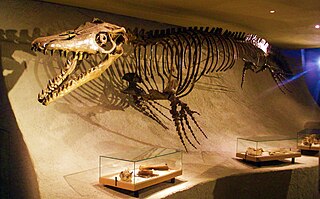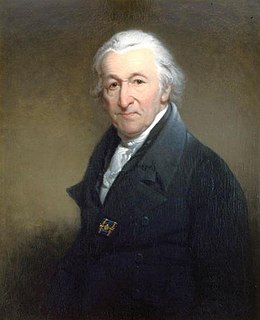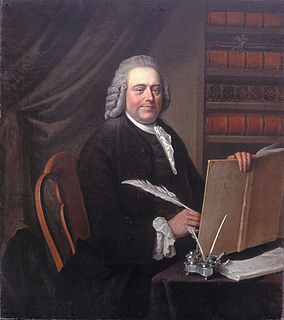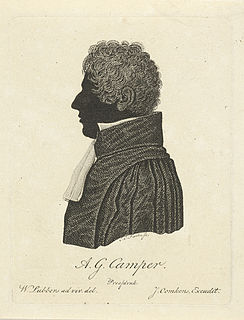
The Frans Hals Museum is a museum located in Haarlem, the Netherlands.

Teylers Museum is an art, natural history, and science museum in Haarlem, Netherlands. Established in 1778, Teylers Museum was founded as a centre for contemporary art and science. The historic centre of the museum is the neoclassical Oval Room (1784), which was built behind the house of Pieter Teyler van der Hulst (1702–1778), the so-called Fundatiehuis. Pieter Teyler was a wealthy cloth merchant and banker of Scottish descent, who bequeathed his fortune for the advancement of religion, art, and science. He was a Mennonite and follower of the Scottish Enlightenment.

Mosasaurus is the type genus of the mosasaurs, an extinct group of aquatic squamate reptiles. It lived from about 82 to 66 million years ago during the Campanian and Maastrichtian stages of the Late Cretaceous. The earliest fossils known to science were found as skulls in a chalk quarry near the Dutch city of Maastricht in the late 1700s, which were initially thought to have been the bones of crocodiles or whales. One particular skull discovered at around 1780, and which was seized during the French Revolutionary Wars for its scientific value and transported to Paris, was famously nicknamed the "great animal of Maastricht". In 1808, naturalist Georges Cuvier concluded that it belonged to a giant marine lizard with similarities to monitor lizards but otherwise unlike any animal known today. This concept was revolutionary at the time and helped support the then-developing ideas of extinction. However, Cuvier did not designate a scientific name for the new animal; this task was completed by William Daniel Conybeare in 1822 when he named it Mosasaurus in reference to its origin in fossil deposits near the Meuse River; the name is accordingly a portmanteau derived from the words Mosa and saurus. The relationships between Mosasaurus and modern reptiles are controversial and scientists continue to debate whether its closest living relatives are monitor lizards or snakes.

Martin(us) van Marum was a Dutch physician, inventor, scientist and teacher, who studied medicine and philosophy in Groningen. Van Marum introduced modern chemistry in the Netherlands after the theories of Lavoisier, and several scientific applications for general use. He became famous for his demonstrations with instruments, most notable the Large electricity machine, to show statical electricity and chemical experiments while curator for the Teylers Museum.

The history of paleontology traces the history of the effort to understand the history of life on Earth by studying the fossil record left behind by living organisms. Since it is concerned with understanding living organisms of the past, paleontology can be considered to be a field of biology, but its historical development has been closely tied to geology and the effort to understand the history of Earth itself.

Pieter Teyler van der Hulst was a wealthy Dutch Mennonite merchant and banker, who died childless, leaving a legacy of two million florins to the pursuit of religion, arts and science in his hometown, that led to the formation of Teyler's Museum. This was not the value of his entire estate. He also founded Teylers Hofje in his name, and made important donations to individuals in the Mennonite community.

Andrias scheuchzeri is an extinct species of giant salamander, which is only known from fossils. It lived from the Oligocene to the Pliocene. It and the extant A. davidianus cannot be mutually diagnosed, and the latter, only described in 1871, is therefore sometimes considered a synonym of the former.

Jacob Gijsbertus Samuël van Breda was a Dutch biologist and geologist.

Tiberius Cornelis Winkler was a Dutch anatomist, zoologist and natural historian, and the second curator of geology, paleontology and mineralogy at Teylers Museum in Haarlem. Besides translating the first edition of Charles Darwin's Origin of Species (1860), he wrote a great number of works popularising science, particularly the life sciences.

Atoposaurus is an extinct genus of crocodylomorph. It is the type genus of the family Atoposauridae. Fossils have been found that were Late Jurassic in age from two distinct species in France and Germany.

Wybrand Hendriks was a Dutch painter, primarily known for his portraits, and the concierge of the Teylers Museum.

The Fundatiehuis is the former family home of Pieter Teyler van der Hulst on the Damstraat 21 in Haarlem, Netherlands. After his death it became the seat of the Teylers Stichting and through its front door, visitors could reach the Oval room.

The Teylers astronomical observatory is an astronomical observatory built in 1784 on the roof of the Oval Room of the Teylers Museum in Haarlem.
Hendrik van Borssum Buisman, was a 20th-century painter from the Northern Netherlands who became the keeper of the print room or art cabinet at Teylers Museum in 1913.

Volkert Simon Maarten van der Willigen, sometimes referred to as Volcardus Simon Martinus van der Willigen, was a Dutch mathematician, physicist and professor.

The Eerste Schilderijenzaal, or Painting Gallery I, is one of two art gallery rooms in Teylers Museum and is the oldest art gallery for contemporary Dutch art in the Netherlands. It was built onto the back of Teylers Oval Room in 1838. It was the young museum's first exhibition space for paintings and could be entered through the Oval Room, which was itself located behind the Fundatiehuis, the former home of Pieter Teyler van der Hulst.

The Tweede Schilderijenzaal, or Painting Gallery II, is one of two art gallery rooms in Teylers Museum. The Tweede Schilderijenzaal was built in 1893 as an extension of the first gallery.

The Instrument Room is a room in Teylers Museum which houses a part of the museum's Cabinet of Physics: a collection of scientific instruments from the 18th and 19th centuries. The instruments in the collection were used for research as well as for educational public demonstrations. Most of them are demonstration models that illustrate various aspects of electricity, acoustics, light, magnetism, thermodynamics, and weights and measures. The rest are high-quality precision instruments that were used for research.

Adriaan Gilles Camper was a 19th-century Dutch mathematics and physics professor at the University of Franeker who took to politics and became a statesman in his later years. He was the son of Petrus Camper is known today primarily for his paleontological work in collaboration with his father, causing several fossil holotypes to be named after him, such as the Puppigerus P. Camperi. The engravings he commissioned on the basis of his father's work were published by Barthélemy Faujas de Saint-Fond. He himself wrote several books on paleontology, including a catalog of his collection of fossils and minerals.

The Teylers Coin and Medal Room, or Numismatisch Kabinet, is a small display room in Teylers Museum that was designed in 1888 and furnished with special display cabinets in 1889.











































